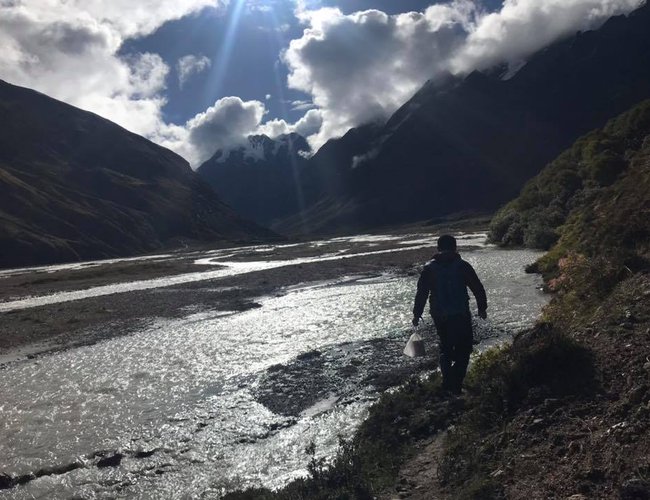
Water supply to Kathmandu valley from the much delayed Melamchi Project would have been insufficient during the dry season months even more than ten years back. Thus, the diversion of the rivers Yangri and Larke to augment the flow of the Melamchi river had been planned even though such diversion would require virtually decommissioning of the existing Melamchi Hydropower.
Obviously, the best choice would have been the implementation of a new type of multipurpose Langtang Project to be implemented primarily to generate cheap electricity and at the same time to augment for free the Melamchi river by discharging abundant Langtang river water used for power generation.
The Langtang river is a sub-tributary of the Bhote-kosi river in Gandak basin whereas the Melamchi, a sub-tributary of the Sun-kosi river in the Kosi basin. There is a need for greater coordination between the relevant ministries in planning and implementation of the Multipurpose Langtang Project or similar other multipurpose projects.
Multipurpose Langtang
The Langtang river is not too far away from the head reach of the Melamchi river. There is a possibility to divert the Langtang river flowing at elevations much higher than the Kathmandu valley to augment the flow of the Melamchi river and at the same time to generate cheap electricity. Once the construction is completed, the surplus carrying capacity of the 28 km long Melamchi tunnel could be used at no additional cost to deliver into the Kathmandu valley the water drawn from the Langtang river for power generation of the proposed Langtang hydropower project.
German Concept
The diversion of the Langtang river for water supply to Kathmandu valley is not a new concept. A study of such diversion was made by GTZ in 1977 (R-3). The study provides the following information.
The idea to augment the limited water resources of the Kathmandu valley by diversion of water from the Langtang / Gosaikund massif was first mentioned by Peter Aufschnaiter in 1960. In 1976 /77 the project was studied on a very preliminary level by Dr. Ing. Cristian Kleinert. This project, originally not listed by HMG of Nepal under the projects to be investigated for possible cooperation with the Germany had been included into the study programme on the initiative of the German Government Mission itself because of the fascinating concept and promising objects. The Mission report points out that at that time the high cost of the project mainly caused by difficult access and transportation would not make it viable to undertake this project for further detailed study.
Fortunately, now the road situation has greatly improved. The diversion of the Langtang river into the Melamchi river can provide enormously high energy potential to generate cheap electricity. It is now possible to use the surplus capacity of the recently built 28 kms long Melamchi tunnel to divert abundant Langtang river water into the Kathmandu valley at no additional cost since the intake of the Melamchi is not too far away from the Langtang river.
Gandak Basin UNDP Study
The concept of the Langtang project solely for power generation was developed under the UNDP supported Gandak basin master plan study (R-2). According to the Gandak Basin Master Plan a 120 m high dam has been proposed on the Langtang rive near Jaithang. The volume of the reservoir would be about 180 million cubic meters. Diversion barrage would be built across the Langtang further downstream at Ghore Tabela. Water drawn from the Langtang barrage would be dropped into the Bhote Kosi river after power generation. Capacity of the Langtang hydropower station operating at ahead of 1500 m would be 175 MW. The length of the conduit would be 14 kms.
Proposed Multipurpose Project
As already mentioned, the head reach of the Melamchi river is not too far away from the UNDP study proposed Langtang barrage at Ghore Tabela despite the fact that the Melamchi is a sub-tributary in Kosi basin whereas the Langtang is in Gandak basin. It is proposed to change the alignment of the Langtang Hydropower project. The hydropower would be planned to drop the Langtang water after power generation into the Melamchi river instead of the Bhote-Kosi. The length of the conduit of the proposed Langtang-Melamchi diversion project could be about 20 kilometers and the gross head of the hydropower would be around 1600 m. Installed capacity of the proposed hydropower would be about 200 MW.
Advantages of the Storage Reservoir
The hydropower potential of the proposed Langtang project is significantly enhanced by the possibility to provide a relatively large storage reservoir, though even in the absence of such reservoir it could still be an attractive multipurpose project. Storage reservoir operation could be planned to provide even during the dry months an uniform flow of around 10 cumecs if the use of the storage water is limited to dry season months when the power supply as well as municipal water supply are greatly constrained.
Why Electricity Cheap?
Of all the site characteristics, hydraulic head is the most important. Design guidelines, 1989 approved by the American Society of Civil Engineers has given some simple reasoning that would help to explain why the super high head Langtang power stations operating at many times greater head by comparision with other hydropower could be built at very low cost. "Very simply if one doubles the head the quantity of water needed to produce a certain amount of energy is halved. Thus, for like site energy development the penstock area and reservoir volume are halved and further large cost reductions occur for powerhouse and machinery costs. This fundamental consideration is at the root of the large cost reductions that occur at higher heads."
Rejuvenation of Bagmati River
Implementation of multipurpose projects like the proposed Multipurpose Langtang project requires greater coordination between relevant ministries and also other concerned agencies. The proposed Langtang project apart from generating cheap energy and augmenting for free the municipal water supply to Kathmandu valley could also help to rejuvenate the virtually dying Bagmati river.
At present the Bagmati River has virtually turned into a city drain. Residents of the Kathmandu valley as well as the large multitude of peoples coming to Pashupatinath Temple each day for worshipping from all over the world are appalled at the miserable sight of the holy Bagmati river. It can hardly be denied that the water scarcity is the prime cause of complete deterioration in condition of the Bagmati . Unfortunately until now we do not have any satisfactory plan to resolve this serious problem. It could be possible after the completion of the proposed Multipurpose Langtang project to transform the Bagmati into a medium sized river that would be carrying a discharge of about 10 cumecs even in the driest months.
References:
(1) Bankable Feasibility Report of Melamchi Diversion Scheme
UNDP & HMG of Nepal, Sept 1995
(2) Gandak River Basin Power Study, UNDP & HMG of Nepal July 1979
(3) Water Resources Development in Nepal, GTZ, Federal Republic of Germany & HMG of Nepal, November, 1977

Dr. A.B. Thapa
Thapa writes on water resources issue
- Dudhkosi Multipurpose Project
- Jul 11, 2022
- Dudh-Kosi Power Project And Kosi Treaty
- Sep 27, 2021
- Uttarakhand Glaciers And Recent Disaster: A Lesson To Our Country
- Mar 02, 2021
- Large Storage Dams Projects Wary of Giving Away Children’s Inheritance
- Dec 22, 2019
- ECONOMIC AND ENVIRONMENTAL CATASTROPHE STORAGE DAM FAILURE
- Nov 17, 2019












